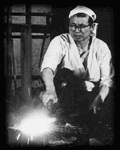
|
|
Japanse Swordmaking Process
 |
This webpage shows the swordmaking process based on valuable photos performed by the late living national treasure, Miyairi Akihira (1913-1977). He entered the Nihonto Tanren Denshusho (directed by Kurihara Hikosaburo Akihide) at the age of 10. He made an unbreakable record of five consecutive "Tokusho" winner in Shinsakuto Gijyutsu Hatpyoukai from 1955 to 1959. In 1960, he became a Mukansa followed by the second living national treasure in 1963. He aimed the Shizu Kaneuji and Soshu style during his life. |




1. Raw material: In ancient times, the resource of the Japanese sword was mainly steel scraps (such as nail, broken pot, plow, etc.) as well as a tamahagane which was refined from the tatara, the traditional iron smelter. Currently, the NBTHK supplies tamahagane to swordsmiths in Japan.2. Sumi-wari: Splitting wood charcoal is the first step for swordmaking, which is called "sumiwari". The best charcoal comes from the pine tree but chestnut tree is also used. To make one sword, about 12 - 15 kg of charcoal is consumed. The different size of charcoals control the forging temperature in the hearth and they provide the carbon into the steel. About 2 - 3 cm of even size is used at Kitae (forging) process but smaller size of 1 - 1.5 cm is used in Yakiire (tempering/quenching) process. This sumiwari process is a very important step for smith trainee (There was an old saying that the trainee had to spend 3 years just to learn sumi-wari). Akihira was well known for spending most of his valueable time in the sumiwari so that he couldn't make more than two swords per month. In order to learn his craftmanship afterward, thesedays no more than two swords/month are allowed to produce by a smith in Japan.3. Aku-zukuri: "Aku" means burnt straw which is used in forging process. Aku is used broadly in forging steps e.g. the fixation of tamahagane on takogane in tsumi-wakashi process.
 |
 |
 |
 |
 |
 |
 |
 |
 |

















 |
 |
 |
 |
 |
 |




















|
|
Copyright 2004, Jinsoo Kim
No part of this webpage can be reproduced
or copied without permission
The text and images are used with permission of Jinsoo Kim.